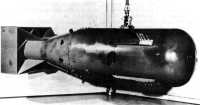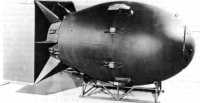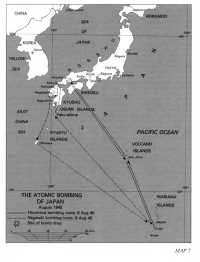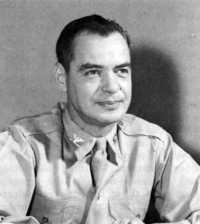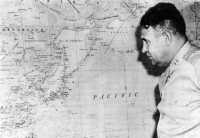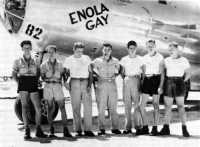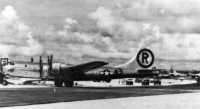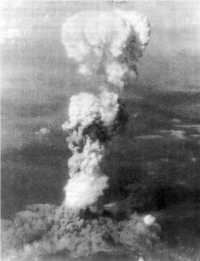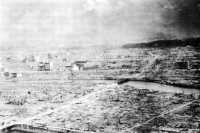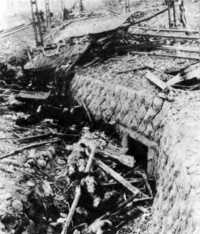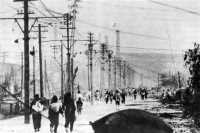Chapter 26: The Atomic Bombing of Japan
The explosion of an implosion device on 16 July 1945 at Trinity provided final confirmation to America’s wartime leaders that employment of an atomic weapon in the war with Japan was indeed a strategic reality. Until 1945, the Army’s super-secret atomic weapon program had not been a factor in strategic planning for carrying on the war, either in Europe or in the Pacific.1 The successful Allied operations against Germany in the summer of 1944 portended that country’s imminent collapse and obviated the need for an atomic weapon to end the conflict in Europe. Because of these developments, Manhattan Project leaders thus considered using the bomb in the war in the Pacific and accelerated preliminary planning with the Army Air Forces (AAF) for a possible atomic bombing mission against Japan.
Preparations for an Atomic Bombing Mission
Preparations for the tactical employment of an atomic weapon against Japan began in late March 1944, when General Groves first met with General Henry H. Arnold, the AAF commanding general.2 The Manhattan commander briefed Arnold, who already had some knowledge of the atomic program, on the current status of bomb development, estimating the probable time when bombs would be ready for use in combat. He then reviewed the latest technical data from Los Alamos on
the likely size, weight, and configuration of an atomic bomb, indicating that the dimensions of the gun type were reasonably well established but those for the implosion type were still very much in question.
The two leaders next took up the question of what type of airplane would be required to transport atomic bombs. The Manhattan commander noted that Oppenheimer, on the basis of investigations carried out at Los Alamos and Muroc Army Air Field, had concluded that a modified B-29 probably had the requisite weight-carrying capacity and range. Should the B-29, which had gone into production in September 1943, prove not feasible, Groves suggested the British Lancaster would have to be considered. This displeased Arnold, who stated emphatically that an American-made airplane should carry the bombs, and he promised to make a special effort to have a B-29 available for that purpose.3
With this assurance that the AAF would provide the necessary airplanes, the two leaders reached tentative agreement on a broad division of responsibilities in making the preparations for that atomic bombing mission. The AAF would organize and train the requisite tactical bomb unit, which, for reasons of security, must be as self-sustaining as possible and exercise full control over delivery of bombs on the targets selected. Manhattan would receive from the AAF whatever assistance it needed in ballistic testing of bombs and air transportation of materials and equipment.
To facilitate close coordination between the two organizations, Groves would continue to have as frequent access to Arnold as he deemed necessary, and Maj. John A. Derry of Groves’ staff and Maj. Gen. Oliver P. Echols, an AAF officer already serving as a consultant with Manhattan, would provide day-to-day liaison. Echols subsequently designated an alternate, Col. Roscoe C. Wilson, who since the latter part of 1943 had been providing AAF liaison with the Los Alamos delivery group in its work on B-29 modification and testing.4
In the ensuing months, General Groves personally assisted the AAF in developing an overall and concrete tactical plan. As soon as the anticipated schedule of fission bomb production was available, Groves supplied Colonel Wilson with the crucial data. Drawing upon estimates he had recently prepared for the Military Policy Committee’s August progress report to the Secretary of War, Chief of Staff, and Vice President, the Manhattan commander indicated to Wilson that an implosion-type bomb might be ready as early as January 1945 and a gun-type bomb by June of that year. Although these dates were slightly in advance of those in the progress report, they illustrate a precautionary maneuver on Groves’ part “to avoid any possible unnecessary delay in the use of the bomb. …”5
Pending completion of the fission bombs, Groves assured Wilson that, for testing purposes, Manhattan would supply the AAF with several hundred high-explosive bombs having ballistic characteristics similar to the implosion-type model.6
On the basis of this data, Wilson drafted a general plan outlining the support the AAF would provide in preparation for the atomic bombing mission. The AAF committed itself to supply the personnel and equipment for a heavy bomb squadron, with attached special units as required, and to make available an air base in the southwestern United States for its training. In addition, it agreed to modify and complete delivery of fourteen B-29’s to the squadron by 1 January 1945; to continue flight testing of implosion-type bombs, with related training under direction of Manhattan and AAF specialists; and to assist Manhattan personnel in testing equipment and assembling ballistic data. Finally, the AAF would participate in a field inspection of a suitable site for an overseas operating base on the Mariana Islands in the Central Pacific.
To command the bomb combat unit, subsequently designated the 509th Composite Group and formally activated on 17 December 1944, General Arnold selected Col. Paul W. Tibbets, Jr. Tibbets had an outstanding record in flying heavy bombers in Europe and North Africa and had gained a special knowledge of the B-29 as a test pilot. Because of the great importance and secrecy of the 509th’s mission, Arnold gave the 509th commander virtual carte blanche to select the best-qualified personnel available.
In September 1944, Colonel Tibbets began to assemble the elements of the 509th at Wendover Field (see Map 2), an isolated air base in western Utah with adequate security and facilities and well located for air travel to Los Alamos and the Salton Sea Naval Air Station.7 The 509th commander devoted the next several months to organizing his new command, consulting frequently with Groves, Captain Parsons of the Los Alamos ordnance group, and other Manhattan representatives. Following the security guidelines set forth in Colonel Wilson’s plan, Tibbets formed the various elements of the 509th with the objective of making it as self-sufficient as possible. Thus, he included in the group not only a normal B-29 unit, the 393rd Bombardment Squadron (VH), but also a number of supporting elements, including the 390th Air Service Group (consisting of the 603rd Air Engineering and 1027th Materiel Squadrons), the 320th Troop Carrier Squadron, and the 1395th Military Police Company (Aviation). Subsequently, for special technical requirements, the 509th acquired the 1st Ordnance Squadron, Special (Aviation), and the 1st Technical Detachment, War Department Miscellaneous Group, a catchall unit comprised of both civilian and military scientists and technicians
Little Boy, the uranium bomb dropped on Hiroshima
– many from the Manhattan Project but including Army, Navy, and AAF personnel.8
At the beginning of September, with the external shape and aircraft requirements of the three basic bomb models – one of the U-235 gun type (now designated Little Boy instead of Thin Man) and two of the Pu-239 implosion type (Fat Man) – now frozen, the AAF started training the bomb drop squadron and, with assistance from Los Alamos technicians, completed necessary modifications on the B-29. While awaiting delivery of the first planes, scheduled under Colonel Wilson’s plan to be on the thirtieth of the month, the squadron underwent training that emphasized ground and air techniques for handling atomic bombs.
In October, only days past the scheduled delivery date, the 393rd received the first modified B-29’s out of a production lot of fifteen (one more than originally requested). Without delay, a continuing series of essential test drops commenced at Wendover. Over the next few months, these tests furnished critical information on ballistics, electrical fusing, flight performance of electrical detonators, operation of aircraft release mechanisms, vibration, and temperatures, as well as provided bomb assembly experience. But, perhaps more importantly, they revealed certain weaknesses in the original modifications and defective performance in the flying capabilities of the big bombers.
Fat Man, the implosion bomb dropped on Nagasaki
Because B-29’s were in very short supply, the AAF’s lower echelons displayed some reluctance to satisfy the Manhattan request for replacement of the inadequate planes. In December, shortly after the 393rd Squadron was detailed to Batista Field, Cuba, for two months of special navigational training, Groves decided to appeal directly to General Arnold about the B-29 problem. Without hesitation, the AAF chief responded emphatically that the 509th Composite Group would get as many new planes as it required. “In view of the vast national effort that had gone into the Manhattan Project,” as Groves later recalled Arnold’s words, “no slip-up on the part of the Air Force was going to be responsible for a failure.”9 After the 393rd returned to Wendover, the fliers continued to gain experience during tests with dummy bombs of various types. Finally, in the spring of 1945, the second lot of fifteen greatly improved versions of the B-29 reached the air base, and training and ballistic tests proceeded at a more intensive pace.
The Overseas Operating Base
With training of the 509th Composite Group and the Los Alamos program for testing bomb models well under way, project leaders turned their attention to establishing a base of operations for the 509th in the Pacific Theater. At the end of December 1944, Manhattan and AAF officials, including Groves and Arnold, met to discuss plans for moving the 509th overseas. The AAF recommended that leaders of the Twentieth Air Force in the Marianas – at the time the only feasible location for the 509th base – be informed of the atomic bomb mission. With permission
from General Marshall, Groves accepted the AAF’s offer to have Brig. Gen. Lauris Norstad, its assistant chief of staff for plans who would be visiting Pacific bases in January 1945, brief Lt. Gen. Millard F. Harmon, deputy commander of the Twentieth Air Force, and two of his staff officers. (Groves had to repeat the briefing again for Lt. Gen. Barney McK. Giles, who in May became Twentieth Air Force deputy commander after Harmon and the two staff officers disappeared in a flight from Guam to Washington, D.C.).10
The meeting reemphasized the need for also informing the Navy commanders in the Pacific of the atomic bomb mission, as Navy support in the immediate area of operations would be indispensable. Furthermore, Admiral Chester W. Nimitz, Commander in Chief, Pacific Ocean Areas (CINCPOA), had learned of the imminent arrival of the 509th in his theater and was asking questions concerning its mission. In February, Groves arranged with Rear Adm. William R. Purnell of the Military Policy Committee to have Comdr. Frederick L. Ashworth, Parsons’ operations officer and military alternate in charge of field operations at Wendover, visit Nimitz’s headquarters on Guam. Ashworth briefed Nimitz, who in turn informed two staff members of the 509th mission.11
Groves also had instructed Commander Ashworth to inspect carefully both Guam and Tinian as possible sites for the 509th base operations. General Norstad had recommended Guam, citing its excellent deep-water harbor and maintenance facilities. But Guam was 125 miles farther from Japan than Tinian – a critical factor considering the heavy load the B-29 would be carrying. Ashworth also found that Guam had overtaxed port facilities and a shortage of construction personnel to build an additional airfield. In contrast, airfield and port facilities under construction on Tinian would be more than adequate for the atomic bomb mission and would be ready for use by the time the 509th arrived in June. Furthermore, although the Army had jurisdiction over Tinian, the Navy’s 6th Naval Construction Brigade was available there to build the special installations that would be needed by the mission.12
With the information he had collected on Guam and Tinian, Commander Ashworth reported to Groves on 22 February. The following day Groves wrote to Norstad, indicating his choice of Tinian as the more suitable site (Map 7). Norstad concurred, and on 24 February Groves briefed the Military Policy Committee. By end of the month, Navy Seabees were at work on the base facilities.13
Map 7: The Atomic Bombing of Japan, August 1945
At the end of March, General Groves sent the District’s deputy engineer, Gol. Elmer E. Kirkpatrick, Jr., a long-time associate of the Manhattan commander on Army construction projects, to the Marianas as his personal representative with the mission of expediting delivery of the bomb components to Tinian and making sure that all essential construction work there was completed on schedule. Groves had brought Kirkpatrick to the project the previous September for the specific purpose of preparing him to monitor development of the overseas operational base. Thus, in the guise of a special assistant to Groves, he had spent considerable time at Los Alamos, Wendover Field, and Kirtland Field (near Albuquerque), assisting in inspection of bomb prototypes, observing the training of the 509th Composite Group, and helping to plan shipment of essential equipment and bomb components to Tinian.14
As soon as Kirkpatrick arrived on Guam, he went to Admiral Nimitz with a letter of introduction from Chief of Naval Operations Admiral Ernest J. King that explained his mission. Nimitz then assigned a member of his own staff, Capt. Thomas B. Hill, as Kirkpatrick’s contact at CINCPOA headquarters. Kirkpatrick also delivered a similar letter from General Arnold to Maj. Gen. Curtis LeMay, commanding general of the XXI Bomber Command. To maintain the secrecy of his mission, Kirkpatrick was identified simply as a special representative from the War Department General Staff to the Twentieth Air Force and its XXI Bomber Command, reporting to General LeMay. He was carried as an assistant operations officer of the bomber command and quartered with the 313th Bombardment Wing, located at the same field on Tinian that would be used by the 509th Composite Group.15
Kirkpatrick devoted April and May to expediting facilities construction. A typical problem was a delay in unloading ships at Tinian harbor. Kirkpatrick notified Groves, who went to Admiral Purnell. The Navy representative on the Military Policy Committee obtained an order from Admiral King to Nimitz that all material for the 509th must be unloaded as soon as it reached Tinian. Another problem arose in constructing facilities on Iwo Jima for transferring an atomic bomb from one B-29 to another, in
Col. Elmer E. Kirkpatrick Jr.
the event a bomber en route to Japan should have to make an emergency landing there. Kirkpatrick had arranged to have these facilities completed by 1 July, but an inspection by a project officer there as of that date revealed that virtually nothing had been done. Kirkpatrick informed Captain Hill, and prompt action was taken.16
In early May, Kirkpatrick came back to the United States for conferences with Groves and with personnel working on design and delivery of the bomb. He visited Captain Parsons at Los Alamos and other project officials there and at Wendover Field and the Inyokern test site. When Kirkpatrick returned to Tinian toward the end of the month, he found the first elements of the 509th arriving there. The group brought with it a number of C-54 transport planes, which were soon operating as a continuous shuttle service to the United States mainland, greatly facilitating movement of personnel and urgently needed equipment. By mid-July, all elements of the group had reached Tinian, including the 1st Technical Detachment comprised chiefly of civilian specialists from Los Alamos, some of whom had been brought temporarily into military service. Commanded by Parsons, the detachment furnished and tested weapon components for the 509th, supervised assembly of bombs, and checked out completed units, carefully inspecting them in bomb bays before planes took off. Frequent communication with Los Alamos threatened project security, so Groves dispatched Lt. Col. Peter de Silva, chief security officer at Los Alamos, to Tinian to establish effective security measures for the detachment, and John H. Manley, a Los Alamos physicist, to Washington, D.C., to serve as point of transmission for all project messages to Tinian.17
Meanwhile, the 509th’s combat crews were undergoing intensive flight training. This involved practicing navigation missions to Iwo Jima and making bomb runs to nearby islands still in enemy hands, using high-explosive projectiles with Fat Man’s pumpkin shape. At the end of
training, which lasted three weeks, the crews in late July began a series of combat strikes over Japan to gain familiarity with target areas and mission tactics and also to accustom the Japanese to the appearance of small formations of B-29’s flying at a great height. Using the pumpkin-shaped bombs, the 509th achieved excellent results against enemy towns, most of which had been hit by previous B-29 strikes. These towns – Koriyama, Nagaoka, Toyama, Kobe, Yokkaichi, Ube, Wakayama, Maizuru, Fukushima, and Niihama – were in the general vicinity of those communities selected earlier as targets for atomic bombing.18
The Bombing Targets
In the late spring and early summer of 1945, Manhattan and AAF representatives met in Washington and Los Alamos for the purpose of choosing targets for the 509th’s atomic bombing mission. Normally the selection of specific bombing targets was a responsibility of the highest echelons in a theater of war. But in April, after briefing President Truman on the atomic program, General Marshall decided that the nature of Manhattan’s security requirements and its inherently unique technical problems made it imperative for project leaders to have a major voice in the choice of targets, subject to final approval by himself and the Secretary of War. Hence, instead of assigning the task to the War Department General Staff’s Operations Division, the Army Chief of Staff turned over this responsibility to General Groves.19
Although the Manhattan commander had not anticipated Marshall’s decision, he moved immediately to carry out his new responsibility. After conferring with General Arnold, he and General Norstad selected a target committee. The committee included two members of Groves’ staff (General Farrell, who served as de facto chairman when Groves was not present, and Major Derry), an AAF officer (Col. William P. Fisher), and five technical experts (John von Neumann, Robert R. Wilson, and William G. Penney, a member of the British team at Los Alamos, all from the Manhattan Project, and Joyce C. Stearns and David M. Dennison from the AAF.20
At the opening meeting of the target committee on 27 April, Groves briefed its members, first emphasizing the need for the highest degree of secrecy in its deliberations and then laying down some general guidelines for selection of targets. He suggested that they choose four targets and indicated that General Marshall had pointed out that ports on the west coast of Japan, vital to that country’s communications with the Asiatic mainland, should not be overlooked. General Norstad then told the committee that the Twentieth Air Force would provide it with whatever support it needed, including related
information, operational analyses, maps, and targets data.21
The second committee meeting took place on 10 May in Los Alamos, where committee members had an opportunity to hear from the scientists and technicians who had worked on the bomb. At the third meeting in Washington on 28 May, Colonel Tibbets and Commander Ashworth, who had returned from Tinian for consultation, and scientific adviser Richard C. Tolman provided further data. The committee carefully considered various criteria: the maximum range for the loaded B-29 aircraft; the need for visual bombing; likely weather conditions; and expected damage. The last criterion weighed heavily on the committee, for it pointed up the necessity to select targets where the bomb would produce the maximum damage and hence have the profoundest impact upon enemy morale. Project scientists had indicated that the bomb would most likely achieve the desired results if it were dropped on densely built-up areas of significant value to the Japanese war effort. They also had emphasized that the targets should not have been bombed previously, so the effects might be assessed more accurately.22
Before concluding its 28 May meeting, the committee recommended four targets to General Groves, who promptly approved all of them. The choices were Kokura Arsenal, one of Japan’s largest munitions plants, covering an area of 8 million square feet; Hiroshima, a major military embarkation port and convoy assembly point with a local army headquarters, railway yards, storage depots, and some heavy industrial plants; Niigata, an important seaport with significant industrial and commercial facilities, including an aluminum reduction plant, a large ironworks, an oil refinery, and a tanker terminal; and Kyoto, with a concentrated 3-square-mile industrial area and a population of about one million people. As soon as he received the committee’s list, Groves prepared a plan of operations for General Marshall based upon the identified target choices.23
On 30 May, before delivering the plan of operations to General Marshall, Groves visited the Secretary of War on other business. The Secretary used the opportunity to query the Manhattan commander on the target choices. As soon as Groves mentioned Kyoto, Stimson expressed strong objection, noting that the city had been the ancient capital of Japan and was a place of great religious and cultural significance to the Japanese. Groves pointed out that Kyoto’s large population and military and industrial importance made it an exceptionally suitable target, but the Secretary of War held fast to his views.
The target committee, nevertheless, did not find an immediate substitute for Kyoto. General Arnold included it
in his instructions in early June to the Twentieth Air Force to withhold conventional bombing of the four selected targets. So did Groves in late June, when he requested General Marshall to inform General Douglas MacArthur and Admiral Nimitz to refrain from attacking the target cities, but probably with the intention of making certain that Kyoto was not subjected to ordinary bombing. The Manhattan commander endeavored to change Stimson’s mind on a number of occasions, but the Secretary remained adamant. Finally, on 21 July, Stimson, who was in Germany attending the Potsdam Conference, received a cable signed by special assistant George L. Harrison but certainly inspired by Groves: “All your local military advisors engaged in preparation definitely favor your pet city and would like to feel free to use it as first choice if those on the ride select it out of 4 possible spots in the light of local conditions at the time.”24 After conferring with President Truman, Stimson replied: “Give name of place or alternate places, always excluding the particular place against which I have decided. My decision has been confirmed by highest authority.”25 When the atomic bomb directive was issued to the United States Army Strategic Air Forces (USASTAF) on 25 July, Nagasaki had replaced Kyoto on the target list.26
The Decision To Use the Bomb
Meanwhile, the question of military employment of the bomb against Japan came up for consideration by the Interim Committee, a temporary body appointed by Stimson in May 1945 at the urging of project leaders and with the approval of the President. The committee’s function was to advise and report on atomic energy matters. Membership was comprised of the Secretary of War, as chairman; George Harrison, as alternate chairman; former War Mobilization Director James F. Byrnes, representing the President; Vannevar Bush; James B. Conant; MIT President Karl T. Compton; Assistant Secretary of State for Economic Affairs William L. Clayton; and Under Secretary of the Navy Ralph A. Bard. At its first meeting on the ninth, Stimson outlined the parameters of the committee’s broad authority – from advising on wartime controls and publicity releases to making recommendations on postwar policies concerning research, development, and control of atomic energy (including legislation). He did not mention that the committee would also advise on the military use of the bomb, but the interrelationship between this aspect of atomic energy and war and postwar controls made
General Groves checking location of bombing targets
its involvement in that decision almost inevitable.27
At its next meeting on the fourteenth, the Interim Committee established a scientific panel, comprised of Oppenheimer, Fermi, Arthur Compton, and Lawrence. This group presented its views on the technical and political aspects of atomic energy at the fourth meeting of the committee on the thirty-first, which Generals Groves and Marshall attended. While recognizing that use of the bomb was essentially a military matter, the panel members nevertheless offered their opinions concerning the way it should be employed and the likely effects it would have on the targets selected. Oppenheimer closed the panel’s briefing by emphasizing that the atomic bomb would have a different impact from any previous weapon because “the visual effect ... would be tremendous, it would be accompanied by a brilliant luminescence which would rise to a height of 10,000 to
20,000 feet, [and] the neutron effect ... would be dangerous to life for a radius of at least two-thirds of a mile.”
Taking a moment to reflect on the discussion of targets and effects, Secretary Stimson proffered the conclusion that the atomic bomb should be used against Japan with no advance warning and, while not restricting the target to a civilian area, should be employed in such a way as “to make a profound psychological impression on as many of the inhabitants as possible.” Both committee and panel members generally agreed, and the discussion continued. Conant suggested that the “most desirable target would be a vital war plant employing a large number of workers and closely surrounded by workers’ houses,” and Stimson indicated that was the type of target he also visualized. When Oppenheimer proposed that several simultaneous strikes would be feasible, Groves strongly objected. Such tactics, he stated, would eliminate the possibility of “gaining additional knowledge of the new weapon at each successive bombing ... , would require a rush job on the part of those assembling the bombs and might, therefore, be ineffective, [and] the effect would not be sufficiently distinct from ... regular Air Force bombing. ...”28
Panel members left the 31 May meeting with the Secretary’s instructions that they should prepare suggestions on postwar organization, research, and development for the Interim Committee. Arthur Compton was very much aware that there was great concern and substantial difference of opinion among Metallurgical Laboratory scientists on how to deal with postwar problems and programs. And in the interest of maintaining the morale of his scientific staff, he requested suggestions from them on the future of atomic energy, which he might then pass on to the scientific panel.
Among the various reports Compton received in the following two weeks was one prepared by a group of scientists under the leadership of James Franck, an outstanding German-refugee physicist who had come to the Metallurgical Laboratory from the staff of the University of Chicago. Centering on the political and social ramifications of an atomic bombing, the Franck report favored eventual international control of atomic energy as the only safe solution. Using the bomb against Japan without adequate warning, the report cautioned, would arouse great animosity against the United States and isolate her morally among the nations of the world, making establishment of international controls much more difficult. As an alternative, the report advocated a demonstration of the bomb in an uninhabited area, pointing out that this action would not prevent later military use of the bomb against Japan, if this were necessary.29
Some members of the Franck group did not feel that they could depend upon the scientific panel to bring their views to the attention of government leaders, so Franck himself carried the report to the capital. There, Arthur Compton saw to its delivery on 12 June to George Harrison’s office at the War Department. Harrison, acting in his capacity as alternate chairman of the Interim Committee, decided that the Franck report should be turned over to the scientific panel for possible inclusion in the latter’s own report on the use of the bomb.
Both the Franck report and the scientific panel’s report were discussed at the meeting of the Interim Committee on the twenty-first. In contrast to the Franck report’s recommendation that the bomb be used first in a technical demonstration made public to other countries, the panel’s report – which acknowledged the differing views of project scientists on how the bomb should be employed – concluded that it could “propose no technical demonstration likely to bring an end to the war ... [and] see no acceptable alternative to direct military use.”30 After considering the panel’s views, the Interim Committee reaffirmed its earlier position “that the weapon be used against Japan at the earliest opportunity . . without warning, and ... on a dual target, namely a military installation or war plant surrounded by or adjacent to homes or other buildings most susceptible to damage.”31
On 21 July, Stimson received not only Groves’ detailed report on the successful test at Trinity, delivered by special courier, but also cables from Harrison indicating that atomic bombs would be ready sooner than expected. He promptly passed the word to American and British leaders at Potsdam, including President Truman, Prime Minister Churchill, Secretary of State Byrnes (as of 3 July), General Marshall, and Lord Cherwell, all of whom were elated by the news. On the twenty-fourth, Stimson showed the President the tentative plan of operations, which Groves had prepared and which he (Stimson) had received the day before from Harrison. This plan called for the first atomic bombing mission any time after 1 August, subject to completion of preparations and suitable weather. Truman accepted the plan without reservation, for, Stimson recalled, “that was just what he wanted. ...”32
On 25 July, General Marshall submitted to Stimson the draft of the USASTAF directive to proceed with the atomic bombing of Japan, and the Secretary – with assurance that all the Allied leaders favored going ahead with employment of the bomb – approved it. The directive carefully spelled out the procedures that were to govern the atomic bombing mission:
1. The 509 Composite Group, 20th Air Force will deliver its first special bomb as soon as weather will permit visual bombing after about 3 August 1945 on one of the targets: Hiroshima, Kokura, Niigata and Nagasaki. To carry military and civilian scientific personnel from the War Department to observe and record the effects of the explosion of the bomb, additional aircaft will accompany the airplane carrying the bomb. The observing planes will stay several miles distant from the point of impact of the bomb.
2. Additional bombs will be delivered on the above targets as soon as made ready by the project staff. Further instructions will be issued concerning targets other than those listed above.
3. Dissemination of any or all information concerning the use of the weapon against Japan is reserved to the Secretary of War and the President of the United States. No communiques on the subject or release of information will be issued by Commanders in the field without specific prior authority. Any news stories will be sent to the War Department for special clearance.
4. The foregoing directive is issued to you by direction and with the approval of the Secretary of War and of the Chief of Staff, USA. It is desired that you personally deliver one copy of this directive to General MacArthur and one copy to Admiral Nimitz for their information.33
Dropping the Bomb
Manhattan played an important supporting role in the AAF’s execution of the 25 July directive. At the top level, General Groves continued to retain a voice in the general direction of the mission, through his access to General Arnold’s staff in Washington, through his two representatives on Tinian (Colonel Kirkpatrick and, as of 31 July, General Farrell) and through Admiral Purnell, whom Admiral King had assigned to coordinate the bombing with Navy commanders in the Pacific Theater.34
General Farrell arrived in the Central Pacific area with specific instructions from Groves: to coordinate ongoing preparations for dropping the first atomic bomb on Japan. Farrell first stopped on Guam, where he conferred with General LeMay, who would shortly become USASTAF
Col. Paul W. Tibbets, Jr. (center), with Ground Crew at Tinian
chief of staff, and with Admiral Nimitz. Moving on to Tinian, Farrell visited Admiral Purnell and Captain Parsons.35
Farrell spent considerable time with Parsons, who talked at length about the intensive activities of the 1st Technical Detachment on Tinian during the month of July. The detachment, with assistance from other elements of the 509th and the Navy, had installed the technical facilities required for assembly and testing of bomb components, especially with Little Boy, and had carefully checked out the emergency reloading facilities at Iwo Jima. Parsons also informed Farrell about the function of his newly formed project technical committee, namely, to assist him in planning and coordinating with AAF elements the complex final tests and assembly of both the gun-type and implosion weapons.36
Component parts and active material for both types of atomic bombs reached the detachment on Tinian only shortly before they were actually used in bombing missions. Those for Little Boy arrived first. Most of its components and the U-235 had left Los Alamos in mid-July in custody of Maj. Robert R. Furman, a special projects officer from Groves’ Washington headquarters, and Capt. James F. Nolan, chief medical officer at the New Mexico installation. They traveled by automobile from Santa Fe to Albuquerque, by airplane to Hamilton Field near San Francisco, thence to Hunters Point to board the cruiser Indianapolis. Crossing the Pacific in record time, they reached Tinian on 26 July.37 Two Los Alamos security officers brought the remaining components and the rest of the active material for Little Boy aboard two C-54 cargo aircraft, the first arriving at Tinian on the twenty-eighth and the second on the following day.38
The 509th technical teams quickly assembled the Little Boy unit, and Parsons requested permission from Groves to drop it as early as 1 August. But weather conditions for the first four days of the month were unsuitable. During this period, the technical teams and bombing crews worked on an around-the-clock basis,
perfecting plans for delivering Little Boy and carrying out tests on Fat Man rehearsal units. At the same time, components for the Fat Man arrived at Tinian aboard two B-29’s that Groves had held at Albuquerque for that purpose and plutonium active material came in aboard a C-54.39
Finally, on the morning of the fifth, AAF meteorologists indicated that visual bombing should be possible over the target cities on the following day, and General LeMay directed that the Littly Boy mission would take place on the sixth. Technical teams loaded the bomb in the Enola Gay B-29 aircraft and completed the final testing of the unit. A few days earlier bomb technicians had worked out a method for reducing the danger of a premature explosion by delaying final arming until the aircraft was airborne. Captain Parsons, who was to go on the flight as the bomb commander, had responsibility for performing this function.
The final briefing took place at midnight, and the weather planes departed for the target area. Hiroshima was the primary target, Kokura second, and then Nagasaki (see Map 7). In the meantime, a C-54 had carried Colonel Kirkpatrick and a crew from the technical group to Iwo Jima to stand by to transfer the bomb to a spare B-29 if the strike aircraft had to land there.40
Enola Gay at Tinian
At 0245 (Tinian time) on 6 August, with Little Boy in her bomb bay and Colonel Tibbets at the controls, the Enola Gay lifted off the Tinian runway, followed at two-minute intervals by two observation planes carrying recording instruments and scientific observers, most of them from the Manhattan Project. Tibbets’ instructions were to choose the target on the basis of reports from the weather planes – Hiroshima was preferred because it was the one target that had no American prisoner-of-war camp – and, if all were closed in, to return with the bomb.41
Captain Parsons kept the log of the flight that described in terse phrases the progress of the historic mission:
0300 Started final loading of gun. 0315 Finished loading.
0605 Headed for the Empire from Iwo.
0730 Red plugs in [these plugs armed the bomb so it would detonate if released].
0741 Started climb. Weather report received that weather over primary and tertiary targets was good but not secondary target.
0838 Leveled off at 32,700 feet.
0847 All Archies [electronic fuses] tested to be OK.
0904 Course west.
0909 Target [Hiroshima] in sight.
0915½ Dropped bomb [Originally scheduled time was 0915]. Flash followed by two slaps on plane. Huge cloud.
1000 Still in sight of cloud which must be over 40,000 feet high.
1003 Fighter reported.
1041 Lost sight of cloud 363 miles from Hiroshima with the aircraft being 26,000 feet high.42
About fifteen minutes after the bomb was dropped, Parsons radioed back to Farrell on Tinian in a special code: “Results clear cut, successful in all respects. Visible results greater than Trinity. Conditions normal in airplane following delivery. Proceeding to Tinian.” Farrell promptly relayed this first report to Groves, waiting anxiously in Washington, but because of unexplained communications delays, it did not reach him until 11:30 P.M. (Washington time) , 5 August, more than four hours after the dropping of the bomb. At 4:30 the next morning Groves received a detailed cable from Farrell, dispatched after return of the Enola Gay to Tinian. This cable became the basis of Groves’ report to General Marshall at the Pentagon and, by telephone, to Stimson at home. Farrell’s, cable also provided most of the confirmation Groves needed to clear for release to the press the President’s statement, prepared earlier by the Interim Committee. The one point on which the cable lacked sufficient information was the amount of damage inflicted on Hiroshima. To avoid any chance of overstatement that might reduce the announcement’s effect on the Japanese, Groves obtained from General LeMay on Guam assurance that the bomb appeared to have caused enormous destruction. Then at 11:00 A.M. the President’s press secretary (Truman was still en route home from Potsdam) released the statement to the waiting newsmen at the White House, giving the American people their first news of the atomic bombing of Japan and of the wartime project that made it possible.43
Meanwhile on Tinian, the 509th’s weapon assembly teams prepared for the first Fat Man mission, scheduled for 11 August. Rapid progress with assembly of the implosion unit led Parsons to propose to Tibbets on the seventh that the mission be moved up to the tenth. But forecasts indicated that a period of bad weather was due to begin on the tenth and last for five days. Would it be possible, Tibbets asked Parsons, to have the bomb ready by the ninth? Parsons expressed uncertainty as to whether the bomb could be safely readied in so short a time, but agreed to try. Working without letup, the technical teams succeeded in assembling, loading, and checking the unit by the evening of the eighth. Kokura was the primary target and Nagasaki, the secondary
Mushroom Cloud over Hiroshima
objective. Niigata was excluded as being too far away from Tinian.44
Shortly before dawn on 9 August, the B-29 strike plane Bock’s Car, with Maj. Charles W. Sweeney as pilot and Commander Ashworth as the bomb commander, prepared to take off with two observer aircraft. Sweeney’s original flight plan designated the same route to Japan via the Volcano Islands followed by the Hiroshima mission, again to provide for an emergency stop if needed on Iwo Jima. Again Colonel Kirkpatrick awaited with a bomb-loading team and a spare B-29. Just before lift-off, the Bock’s Car crew discovered that the fuel pump for the plane’s reserve gasoline tank in the bomb bay was not working properly. Normally such a mechanical problem would have aborted the mission. But faced with a prediction of worsening weather and knowing the importance to the Allied surrender negotiations with Japan of having a second atomic bomb attack closely follow the first, Farrell decided to risk going ahead with the mission.45
The defective fuel pump was only one of a number of difficulties that were to make the second atomic bombing mission as eventful as the first was routine. Taking off at about 0347,46 the strike plane and accompanying aircraft did not attempt to fly in formation because of the bad weather between Tinian and Iwo Jima. To get around this weather and to save fuel, they headed separately for a rendezvous point at Yaku-shima off the coast of Japan. Commander Ashworth succinctly recorded in the log of the flight the succeeding series of events that threatened the mission with failure and very nearly with disaster:
0900 Arrived rendezvous point at Yakashima [sic] and circled awaiting accompanying aircraft.
0920 One B-29 sighted and joined in formation.
0950 Departed from Yakashima [sic] proceeding to primary target Kokura having failed to rendezvous with second B-29. The weather reports received by radio indicated good weather at Kokura (3/10 low clouds, no intermediate or high clouds, and forecast of improving conditions). The weather reports for Nagasaki were good but increasing cloudiness was forecast. For this reason the primary target was selected.
1044 Arrived initial point and started bombing runs on target. Target was obscured by heavy ground haze and smoke. Two additional runs were made hoping that the target might be picked up after closer observations. However, at no time was the aiming point seen. It was then decided to proceed to Nagasaki after approximately 45 minutes spent in target area.
At this point, Ashworth and Sweeney determined they had only enough gasoline to make a single bombing run over Nagasaki, if they were to reach the closest alternate landing
field on Okinawa. More than one run would require ditching Bock’s Car:
1150 Arrived in Nagasaki target area. Approach to target was entirely by radar. At 1150 the bomb was dropped after a 20 second visual bombing run. The bomb functioned normally in all respects.
1205 Departed for Okinawa after having circled smoke column. …
1351 Landed at Yontan Field, Okinawa.
1706 Departed Okinawa for Tinian.
2245 Landed at Tinian.
Ashworth radioed first word of the bombing of Nagasaki to Farrell on Tinian while Bock’s Car was en route to Okinawa, indicating some uncertainty as to the results, although the visible effects appeared to him about equivalent to those at Hiroshima. On Okinawa, Ashworth consulted with all the crews and observers and concluded that the implosion bomb had been satisfactorily placed over the target. They reported that the flash was brighter, the shock waves greater, and the cloud was larger and moved up faster than at Hiroshima. But photographs taken four hours after the strike showed little because of the cloud, smoke, and dust cover. Only days later would additional photographs reveal that the entire industrial part of Nagasaki and a considerable part of the residential area had been destroyed.47
The Surrender of Japan
As soon as he received word of the successful bombing of Nagasaki, General Groves felt certain Japan’s capitulation would follow. He went at once to see General Marshall to discuss future operations against Japan. They agreed that, in view of Stimson’s policy of using the bomb only to end the war, shipment of materials for a third bomb should be delayed until 13 August. When by that date the Japanese still had not surrendered, neither the Secretary of War nor the Chief of Staff was available to Groves for consultation because of the continuing negotiations for an armistice. Groves then went to General Thomas T. Handy, Acting Chief of Staff, and informed him that he would order the continued holding of all fissionable materials in the United States, requesting Handy to pass this information on to Stimson and Marshall at the earliest opportunity. Meanwhile, project personnel at Los Alamos and on Tinian also continued in full readiness to prepare and deliver additional atomic bombs.48
The march of events vindicated Groves in his decision. On 14 August, President Truman received a message from the Japanese government that constituted full and satisfactory acceptance of the Allied terms of surrender, as set forth in the Potsdam Declaration. The judicious employment of atomic bombs in tandem with a series of warnings to the Japanese government of more to come if it did not yield had comprised the strategy in the final successful maneuverings for the surrender. To the average observer in the West in mid-1945, the Japanese decision to comply with Allied terms appeared to be the direct result of the atomic bombing of Hiroshima
and Nagasaki, the Soviet Union’s declaration of war against Japan on 9 August, and the Allied promise not to alter the legal position of Emperor Hirohito. Yet, with the advantage of hindsight and a detailed knowledge of developments within Japan in the weeks preceding the surrender, a leading historian on the subject makes clear that the “decision – in embryo – had long been taking shape.”49
By the spring of 1945, the Japanese armed forces had brought the Empire to the brink of disaster. Broad public support for the military had begun to disintegrate as the people of Japan came to realize that the very survival of their country was threatened. When Premier Kantaro Suzuki replaced General Hideki Tojo in April, the government initiated a definite campaign to seek an end of the war on terms acceptable to the ruling elite. But this campaign, begun in June with efforts to open peace negotiations through the Soviet Union, was of little avail as long as the Japanese militarists dominated the government and the Allies were unwilling to guarantee the future status of the Emperor. Only the shock impact of the atomic bombings of Hiroshima and Nagasaki, combined with the Soviet entry into the war, created “that unusual atmosphere in which the theretofore static factors of the Emperor could be made active in such an extraordinary way as to work what was virtually a political miracle. … It was the nation’s good fortune that, in spite of the existence of a hard-headed and strong-willed corps of fanatics, the men responsible for the movement to terminate the war were finally able, under the circumstances of 1945, to give the fullest possible effect to the depth of appeal in the voice of the man who is the supreme symbol in Japanese life and thought.”50
The surrender of Japan on 14 August completed the mission of Manhattan’s Project Alberta group, assigned to the 1st Technical Detachment, on Tinian. Most technical personnel of the Alberta group originally planned to return to the United States on the twentieth, leaving only a small team under General Farrell that was to go to Japan to investigate the results of the bombing. But when delays developed in arranging surrender procedures, General Groves requested that essential project personnel remain on Tinian pending successful completion of the occupation of Japan. Project Alberta scientists and technicians finally left Tinian on 7 September. Colonel Kirkpatrick and Commander Ashworth stayed behind to make final disposition of project property, taking special care to return to Los Alamos under guard or to dump in the sea any items likely to reveal information about the bomb. Some project property went with the investigating teams assembled under General Farrell, to be used in surveying the effects of atomic bombing on Hiroshima and Nagasaki.51
Survey of the Bombing Effects
The swift surrender of Japan opened the way for American scientific teams to survey, on the ground, the specific effects of the atomic bombing of Hiroshima and Nagasaki. Not only were scientists, medical personnel, and professional military men greatly interested in learning the results of the first employment of atomic weapons in warfare, but also the commanders of the occupation troops that were scheduled shortly to move into the two bombed cities desired a check of the possible hazards with which they might have to cope. Although Manhattan scientists were virtually sure that detonation of the atomic bombs a considerable distance above the ground had eliminated the likelihood of any lingering large-scale radioactivity in the two cities, lacking previous experience they could not be certain without actual inspection of the affected areas.52
Thus, when General Groves heard from General Marshall on 10 August that the Japanese had started surrender negotiations, he took steps to organize Manhattan Project teams to carry out atomic investigations in Hiroshima and Nagasaki, as well as elsewhere in the home islands. On the eleventh, the Manhattan commander directed District Engineer Nichols to select qualified project personnel and procure the special equipment the teams would need to perform their mission. He also sent instructions to General Farrell that he was to be in command of the Manhattan survey teams going into Japan. Farrell began to assemble medical, scientific, and intelligence personnel already on Tinian to participate in the investigations. On the twelfth, three days before General MacArthur’s appointment as Supreme Commander for the Allied Powers (SCAP), Japan, General Marshall informed him of the purpose of the survey groups, clearing the way for their early entry into Japan.
Meanwhile, Colonel Nichols, with assistance primarily from the medical staff of the District, hurriedly brought together fifteen officers and twelve
enlisted men from the Clinton Laboratories, Metallurgical Laboratory, Los Alamos, the Monsanto Chemical Company, and the University of Rochester. Comprised chiefly of medical scientists and individuals trained in taking radiation measurements, this group rendezvoused on the twelfth at Hamilton Field in California and departed for Tinian on the following day.
When the project’s survey group reached Tinian on the sixteenth, they joined the group General Farrell had organized, which included not only Manhattan personnel but also several AAF representatives and two interpreters. Groves had designated Major Furman, who had participated in Manhattan’s scientific intelligence activities in Europe, to lead a unit with a similar mission of investigating the progress of atomic research in Japan.
While the assembled survey personnel marked time in late August, General Farrell formed them into three teams. The first team going to Japan included Farrell himself, Brig. Gen. James B. Newman, Jr., of the AAF, who served as his deputy; medical and intelligence officers; and officers trained in metallurgy. In the other two teams, he included chiefly medical officers. Col. Stafford L. Warren, chief of the Manhattan District’s Medical Section, commanded the Nagasaki group, while his deputy in the Medical Section, Lt. Col. Hymer L. Friedell, led the Hiroshima team.
Negotiations with the Japanese to arrange for an early entry into Hiroshima and Nagasaki culminated in formation of a special party, comprised mostly of medical personnel from the International Red Cross, the Army Medical Corps, MacArthur’s staff, and the Manhattan Project. The Manhattan contingent consisted of Farrell, Newman, Warren (whom Farrell had relieved temporarily of his assignment as chief of the Nagasaki team so that he could serve as his medical consultant), and a medical and an intelligence officer. The special party, accompanied by two representatives of the Japanese government, flew into Hiroshima on 8 September. Using Geiger counters and other instruments, members of the party checked through the destroyed area of the city, determining that no significant amounts of radioactivity persisted. A Signal Corps photographer with the party took some of the first official pictures of the damage wrought by the bomb. Completing the preliminary survey in a few days, the special party (except for Farrell and Newman who had left earlier for a hurried visit to Nagasaki) returned to Tokyo.
Meanwhile, Colonel Warren’s team reached Nagasaki on 17 September and began three weeks of intensive investigation of damage and injuries wrought by the bomb in that city. The group concentrated on gathering data concerning the nature of casualties. It examined survivors in the nearby Omura Naval Hospital and obtained autopsy records of those who were killed or died of injuries. A new detail of officers from the Army Medical Corps relieved Warren’s team in early October, and it departed from Nagasaki on the sixth, arriving back in the United States on the fifteenth.
A series of typhoons prevented Colonel Friedell’s team from reaching Hiroshima until 26 September. It had only about a week to carry out investigations
designed to supplement the preliminary data collected by Farrell’s party. Departing Hiroshima on 3 October, Friedell’s team joined the Nagasaki group for the return trip to the United States.
Other investigative groups, some of them sponsored by the Army, also conducted surveys of the effects of the atomic bombing of Japan in late 1945 and 1946. SCAP headquarters had established a Joint Commission for the Investigation of the Atomic Bombing of Japan during the period when the Manhattan Project survey was in progress. Commission teams comprised chiefly of Army medical personnel and Japanese scientists worked closely with the Manhattan teams, which were viewed as part of the commission’s survey organization. The commission’s personnel continued to work in Hiroshima and Nagasaki after the departure of the Manhattan teams, extending studies begun by the bomb project groups.
The Manhattan teams also cooperated with the group sent to Japan by the United States Strategic Bombing Survey (USSBS), an organization established by the War Department in 1944. The USSBS had received a request from the President in August 1945 to conduct a study of the effects of all types of air attack in the war against Japan, including the employment of atomic bombs. In addition, the Secretary of War retained Maj. Alexander de Seversky, a well-known aviator and aeronautics engineer, to serve as his special consultant on the results of employing air power in the Pacific Theater, including the atomic bombing of Hiroshima and Nagasaki. The Navy had its own special investigative unit, the Naval Technical Mis 545
sion to Japan, which collaborated with Manhattan teams. The British Mission arrived too late to work with the Manhattan groups, but cooperated with the USSBS in surveys of Hiroshima and Nagasaki in November 1945.
All of the survey groups eventually published reports of their observations and conclusions concerning the effects of the atomic bombing of Hiroshima and Nagasaki. The Manhattan District released its report on 30 June 1946, summarizing the physical damage, medical findings, and other pertinent observations made by its survey teams.
Both cities had suffered extensive physical damage to structures and other inanimate objects as a result of the tremendous blast and conflagration, the latter caused by heat from the atomic explosion, collapse of buildings, overturned stoves, shorting out of electrical systems, and spread of fire. Within a radius of 1 mile of the epicenter of the explosion, destruction in both cities was virtually complete, except for the frames of a few reinforced concrete buildings. Because of differences in topography and layout of the cities, more than 5 square miles of Hiroshima were totally devastated, while only 3 square miles of Nagasaki were similarly destroyed. In the relatively flat terrain of Hiroshima there was heavy damage to almost everything up to 2 miles from the blast center, destruction of 50 percent or more up to 3 miles, and comparatively light damage for several miles beyond, with broken glass as far away as 12 miles. In the rougher terrain of Nagasaki, severe damage extended for about 3 miles north and south in the valley where
Physical Damage at Hiroshima
the bomb had been dropped and generally shorter distances up the hillsides to the east and west, but with partial damage or fire as far as 4 miles out from the blast center at certain points.
The various survey groups were able to obtain a reasonably accurate assessment of the actual physical damage, but they all experienced greater difficulty in securing a clear picture of the effect on the inhabitants of the two cities. The Manhattan teams, for example, were handicapped by the length of time that had elapsed before they were able to enter the cities. They also found that Japanese public officials lacked precise statistical data on the actual population of the two stricken communi ties at the time of the bombings and on the subsequent movement of people in and out of the cities. The extensive destruction of such record-keeping civil organizations as hospitals, fire and police departments, and other government agencies further complicated the collection of accurate statistics.
Thus, the Manhattan teams had to derive most of their medical data from examining the injured; analysis of death records, including autopsy reports; and tabulation of such data as the Japanese had compiled. The District released its survey results in June 1946, including the estimate of casualties that differed somewhat from those released by other groups (Table 3).
Table 3: Comparative Estimates of Atomic Bombing Casualties in World War II
| MED June 1946 | USSBS March 1947 | OSW (Japan) and USNR April 1966 | |||||
| City | Population 1945 | Dead | Injured | Dead | Injured | Dead | Injured |
| Hiroshima | 255,000 | 66,000 | 69,000 | 80,000 | 80,000–100,000 | 70,000 | 70,000 |
| Nagasaki | 195,000 | 39,000 | 25,000 | 45,000 | 50,000–60,000 | 36,000 | 40,000 |
| Total | 450,000 | 105,000 | 94,000 | 125,000 | 130,000–160,000 | 106,000 | 110,000 |
Sources: Ms, MED, “The Atomic Bombings of Hiroshima and Nagasaki,” June 1946, LC; USSBS, The Effects of Atomic Bombs on Health and Medical Services in Hiroshima and Nagasaki; OSW (Japan) and USNR, Analysis of Japanese Nuclear Casualty Data. See also MDH, Bk. 1, Vol. 4, pp. 6.12–6.15, DASA.
Manhattan’s survey data did not mention that American prisoners of war held in a camp in Hiroshima were among the atomic bombing casualties. The Commander in Chief, U.S. Army Forces, Pacific, had received information that about twenty American airmen from the crews of airplanes shot down over Japan were killed in the bombing of Hiroshima. Subsequent information provided by Japanese officials appeared to confirm the presence of the airmen in Hiroshima on 6 August 1945.53
A primary objective of the Manhattan survey teams was to ascertain the particular kinds of injuries suffered, with special attention to the effects of radioactivity. By far the largest number of casualties resulted from burns traceable to the heat of the explosion and the fires generated by it and secondary causes. Other major sources of injury were falling debris, pressure of the blast, and radiation. Most radiation injuries occurred from exposure of the victims to gamma rays at the time of the explosion. There was little evidence of casualties from alpha and beta rays and from residual radioactivity in the bombed-out areas.
While giving less attention to the psychological impact, the teams nevertheless ranked terror with physical damage and human death and injury as the three most important effects of the new weapon. They particularly noted the immediate panic caused by the explosions, followed by a temporary mass exodus from the cities. Residents who had generally ignored the appearance of only one or two enemy aircraft moved promptly into air raid shelters at the slightest indication of enemy air activity overhead.
The USSBS, unlike the Manhattan survey, devoted considerable effort to trying to determine the effects of the bombs on the attitude of the Japanese people toward the war and the decision of the Japanese government to surrender. It reaffirmed the substantial adverse impact the bombs had on the morale of the local inhabitants of
Atomic bombing casualties at Nagasaki
Hiroshima and Nagasaki. But the USSBS found that, in the relatively brief period between the dropping of the bombs and the start of surrender negotiations, people elsewhere in Japan had “neither time nor understanding of the revolutionary threat of the atomic bomb ... to see in [them] a final blow to Japan’s prospects for victory or negotiated peace.”54 The USSBS concluded also that, while the bombs had some impact on the leaders of the Japanese government, their knowledge of the awesome character of the new weapon seems not to have played a significant part in convincing them of the need to surrender.
The USSBS and virtually all the other survey groups that inspected the results of the attacks on Hiroshima and Nagasaki agreed with the Manhattan teams’ assessment that the atomic bomb was indeed a revolutionary new device capable of inflicting damage and casualties on a scale far beyond any existing weapon available for use in modern warfare. The one dissent to this view among the survey groups came from Major de Seversky, who had made a hurried one-man inspection of Hiroshima and Nagasaki in the fall of 1945. He contended that the other survey groups had greatly exaggerated the effects of the bombs and misinterpreted the character of the destruction they had wrought. He asserted that about 200 B-29’s loaded with incendiaries could have accomplished an equivalent amount of damage. Furthermore, he argued, atomic bombs dropped on modern cities, such as New York or Chicago, would do no more damage than a 10-ton blockbuster. The wide circulation of de Seversky’s conclusions in newspapers and the publication of his article, “Atomic Bomb Hysteria,” in the February 1946 issue of Reader’s Digest created a public controversy. As a result, the Senate Special Committee on Atomic Energy, at work on preparing legislation for the peacetime control of the new energy source, invited de Seversky and representatives of the Manhattan Project, the USSBS, and other appropriate organizations to present their views at its 15 February session.55
Survivors of the Nagasaki bombing returning to the devastated city
Representing the Manhattan Project at the hearing were General Farrell and Colonel Warren. Farrell concentrated on refuting de Seversky’s downgrading of the psychological and physical effects of the bombing of Japan. De Seversky, he said, underestimated the psychological damage created by the instantaneousness of an atomic explosion and the lack of any effective defense against it. He challenged the accuracy of de Seversky’s data on the comparative damage possible with conventional air weapons and stated that the evidence collected by the Manhattan survey teams indicated that at least 703 B-29’s would be required to do the physical damage caused by the atomic bomb at Hiroshima. While expressing concern with the popular tendency to overestimate the power of the bombs, Farrell asserted that “if two bombs will do what was done to Hiroshima and Nagasaki, put two cities out of commission and stop a war, I think it is [sic] a fairly effective weapon.”56
Colonel Warren generally supplemented General Farrell’s testimony on the extensive physical damage, caused by fire and the blast effect, in Hiroshima and Nagasaki. He emphasized especially the difficulty of arriving at any accurate conclusions on what had actually happened on the
basis of observations made and information gathered in the period of a few days of hurried inspection, such as that carried out by Major de Seversky. He cited, for example, the impossibility of arriving at an accurate estimate of casualties without a great deal more investigation and analysis, as the Japanese themselves were not able to furnish reliable statistics. Because of confusion, shock, and panic, Japanese medical officials had not kept adequate records of mortalities and injuries caused by the bombs. Colonel Warren reinforced General Farrell’s conclusion “that a tremendous amount of destruction occurred” and the atomic bomb had accomplished “the job it was intended to do.”57
For the most part representatives of the USSBS and other experts supported the views expressed by Farrell and Warren. In the face of almost unanimous disagreement, de Seversky persisted in his contention that a Hiroshima-type atomic bomb was not any more effective against the stone, concrete, and brick structures in Western cities than a well-placed 10-ton blockbuster. He did concede, however, that a final understanding of the potentialities of atomic bombs as weapons of war would be possible only after a much more thorough and careful investigation and analysis of their effects on Hiroshima and Nagasaki.
Personnel of the Manhattan Project had participated in almost every aspect of the planning and preparations for employment of atomic bombs against Japan: in the decision to use the bombs against Japanese cities; in the choice of targets; in the development of an overseas base; and, finally, in the assessment of the damage wrought. The destruction of Hiroshima and Nagasaki marked their efforts with complete technical success and contributed significantly to ending World War II. Yet the respite that the project’s success had afforded was momentary, for looming on the horizon was another threat to the security of the nations of the world – how to control this revolutionary new force in a peacetime environment. In face of this profound problem, the Manhattan Project would continue to operate in the emerging postwar period and its personnel would assume a role in guiding the domestic and international efforts to ensure that atomic energy would best serve the needs of mankind.
